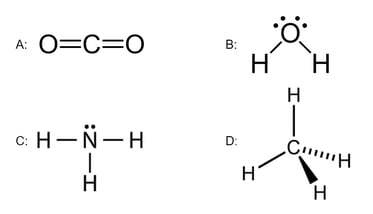Question 1a
a)
Yellow phosphorus reacts with chlorine to form phosphorus trichloride, PCl3.
i)
Draw the Lewis (electron dot) structure of phosphorus trichloride.
[1]
ii)
Predict the Cl-P-Cl bond angle and molecular geometry of the phosphorus trichoride molecule.
[2]
Question 1b
b)
Phosphorus trichloride, PCl3, can form a co-ordinate bond with a hydrogen ion to form HPCl3+.
i)
Draw the Lewis (electron dot) structure of HPCl3+.
[2]
ii)
Predict the bond angle and molecular geometry of HPCl3+.
[2]
Question 1c
c)
BCl3 has three electron domains in a trigonal planar structure.
BCl3 is not a polar molecule, but PCl3 is.
Explain this difference using section 8 of the Data booklet.
[4]
Question 1d
d)
PCl4+ has the same electron domain geometry as HPCl3+.
Explain why PCl4+ is not a polar molecule.
[2]

